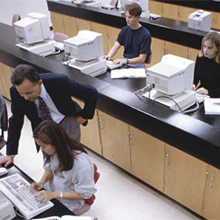 |
| Over the life of contract, ADT expects to install video surveillance cameras, access card readers, alarms, sensors |
Future Proofing
It’s a long way from today’s suburb of Denver to the 1970s of artist Andy Warhol. But he may have had good advice for Robin Brown: “They always say time changes things, but you actually have to change them yourself.”
Brown, director of electronic security at the University of Colorado at Denver and Health Sciences Center, faces a billion dollar-plus project of renovation and new construction with a security aim to future proof what will be America’s top-notch life sciences campus. To accomplish such an aggressive business goal, Brown has partnered with a systems integrator as dedicated to his goals.
Located in Aurora, Colo., the former Fitzsimons Army Medical Center has a colourful and historic past. Built beginning in 1918, the base has served as a home and hospital for troops from World War I through the early 1990s Desert Storm operation. President Eisenhower stayed seven weeks in 1955 while recuperating from a heart attack. Former presidential candidate Sen. John Kerry was born there in 1943.
But major changes will turn the former Army post into a “Silicon Valley of life sciences” after being decommissioned and turned over to the University of Colorado. The university now is moving forward with an ambitious plan to demolish some buildings, renovate others and build a host of new medical-related facilities over the next 10 years.
By the end of 2007, more than $1.3 billion will be spent to add 2.7 million square feet of space. Facilities totaling another 1.5 million square feet are planned for later phases. When finished, the University of Colorado at Denver and Health Sciences Center (UCDHSC) will include five medical schools and a variety of hospitals, laboratories, classrooms, medical offices and other research facilities. It will become the largest such center west of the Mississippi River.
Protecting this vast investment in people, buildings, equipment and research falls largely to Robin Brown. A 23-year veteran of the FBI, Brown created the security department at UCDHSC when he took the job two years ago. He and his staff of seven work in conjunction with the campus police department.
“This is like building a city from scratch,” Brown said. “The work we are doing is critical as the university is looking at this becoming a premier research center that will help the staff to win grants and attract contributions to fund vital medical research, treatment and education. We need to make security as much a part of these buildings as the air conditioning or lighting.”
Working with Brown to help design an electronic security plan is Boca Raton, Fla.-based ADT Security Services, Inc. Last year, ADT won a competitive bid for a five-year contract to serve as the project’s sole electronic security provider. “Having a resource-rich organization such as ADT is a key to our success,” Brown said.
Over the life of the contract, ADT expects to install hundreds of video surveillance cameras and thousands of access card readers, alarms, sensors and monitoring equipment. The systems integrator will also maintain the equipment once installed and is also involved in the retrofit and then decommissioning of the old campus in Denver. As the project evolves, service tickets for the systems integrator are revised once a week.
“Within a year, we hope to have monitors in all campus police vehicles giving officers access to the mapping feature and related video so that they will have a better idea of what to expect when responding to an alarm" |
As new buildings are completed and ground is broken for others, the security staff works with the police, staff, doctors, researchers – even regular visitors to the campus – to identify and remedy security concerns. For example, Brown said lighting has been added to areas where people said they felt unsafe at night. The ever-growing video surveillance system frequently is being used to “escort” staff to the parking lots after dark.
“As we identify risk, we work with ADT to identify the best method to mitigate that risk,” Brown said. “We try to make sure that we protect people first and then the property and resources. You can tell people on campus that they are safe, but they have to believe it. The perception is important.”
There are diverse technologies in the design. A C CURE 8000 access control system by Software House currently monitors about 250 card readers. That number will swell to about 1,500 within the next few years. Biometric readers are on doors to what the university calls “high-value” laboratories. These research labs may contain highly contagious diseases such as tuberculosis or the SARS virus. For the labs, protection will be at biosafety level 4. There are freezers in the labs that demand environmental monitoring. Warnings will be delivered by pages and email.
The access system also automatically locks all building entries each evening. “If you are outdoors at 6 p.m., you can hear all the doors locking at once,” said Mike Abbott, ADT’s national accounts manager.
There is currently a mixture of about 100 dome and fixed cameras from American Dynamics, Pelco and Burle spread across the campus. A minimum of 200 more cameras are planned for installation as building construction continues. The cameras provide video of building perimeters, certain interiors, entries, and parking lots and garages. No cameras are or will be placed to monitor any medical treatment, research areas or individual workplaces, Brown said.
Code Blue panic alarms, placed strategically around the campus, allow for immediate voice access to the campus police.
The heart of the electronic security system is a command and control center adjacent to the campus police headquarters and dispatch center. All entries into reader-protected doors record and display on a 20-inch monitor. By mouse clicking on any entry, the system displays the name and an identification photo associated with the card that was used. An access card is also required in order to exit many laboratories.
An Ageis software package from CapLogic displays on an adjacent access control monitor. It provides a graphical interface showing the campus layout and all alarm points. In case of an alarm, a security operator clicks on the highlighted site to see the most recent access activity and live and/or recorded video of the location.
“Within a year, we hope to have monitors in all campus police vehicles giving officers access to the mapping feature and related video so that they will have a better idea of what to expect when responding to an alarm,” said Tom Cummiskey, ADT’s director of national accounts.
The Intellex units provide a video tour of the buildings by sequentially rotating through the cameras and also allow for a rapid search of recorded video based on criteria such as date, time |
During an alarm event, video displays on one of two 42-inch wall-mounted plasma monitors. Ten Intellex video management systems from American Dynamics can each record 16 cameras simultaneously. In non-alarm situations, the video displays on four 20-inch colour monitors. Brown will add additional monitors as more cameras come online. The Intellex units provide a video tour of the buildings by sequentially rotating through the cameras and also allow for a rapid search of recorded video based on criteria such as date, time, changes in lighting, motion or activities within a user-defined area.
The control room also houses a redundant server so that there will be no interruption in the electronic security system should the main unit fail.
Brown said he is aware of the value his department brings to the ultimate success of the UCDHSC. He is also aware that the project is being counted on to provide much more than just quality medical instruction, treatment and research.
“When fully built out, this project is expected to generate 14,000 jobs and help revitalize the surrounding neighbourhoods with new housing, retail operations and other businesses,” Brown said. “With expectations like that, our job takes on an even greater importance.”

















